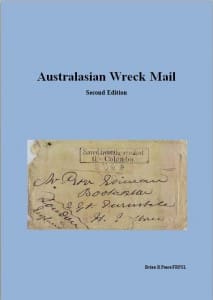AUSTRALASIAN WRECK MAIL: Second Edition
Sixteen years since the publication of the first edition by the Royal Philatelic Society of Victoria, this Second Edition is the result of some painstaking research. The author has not only identified a further eighty wrecks involving mail, he has analysed certain of the best-known wrecks, such as the 1862 Colombo and the 1894 Wairarapa, to the extent that anyone having a cover will be able to check the provenance, establish its relative scarcity and identify the type of cachet.
The book will not only be of benefit to collectors, but also a useful tool for dealers and auctioneers. When offering wreck covers for sale, vendors often mis-describe the item or attribute to it a scarcity or even uniqueness which is not wholly deserved. The author has included a census of recorded survivors from most of the significant wrecks including the 1862 Colombo, 1881 Tararua, 1894 Wairarapa, 1897 Orotava, 1908 Aeon, 1930 Tahiti and 1945 Green Hill Park.
In the First Edition the author listed three wrecks in 1851-52 where the masters of vessels had burned the mail. The reason for this was not then apparent, but the author has now produced evidence that this procedure followed an Admiralty Order. In the case of the 1859 Admella wreck, an Appendix is included which details the trial of a Post Office employee who stole valuables from mail recovered from the wreck. The case is of particular interest as the detailed procedures in processing mail recovered from shipwrecks are explained by the Post Office officials giving evidence.
Mechanical breakdowns are in a separate chapter; and they have been relegated to a ‘second division’. There were hundreds, perhaps even thousands, of breakdowns affecting vessels used for nineteenth century mail services, some of which delayed the mail by weeks, and others which delayed the vessel but did not affect the schedule. The author has been selective and attempted to include only those breakdowns which delayed the mail or necessitated the unscheduled transfer of mail to another vessel. He points out that the effect upon schedules reduced in direct proportion to the size and mechanical sophistication of the mail-carrying vessels, such that by the end of the nineteenth century mechanical breakdowns became a minor factor.
In the Introduction a few paragraphs have been included on the matter of colour. Any differences of opinion over the colour of a cachet are effectively eliminated, in that the author seems to refer only to black, grey, purple, red and blue. He points out that there are no shades in colour science; only hues. Thus Tahiti cachets are purple or black and there is no reference to magenta, nor to violet, indigo or any other colour mix. This does simplify matters.
The tables have been simplified; all are now in portrait format, and in a larger typeface.
In a larger A4 format in full colour this book represents a dramatic step forward (the original was printed in black and white in a smaller format). It contains 433 pages and yet is priced very competitively at £70.
